
A NATURAL HISTORY OF SPRING -
CAUTION:
POOR SLEDDING
"Spring is at hand. I take this early occasion to notify the public
of my opinion and to support it with collateral facts." - Stephen
Leacock
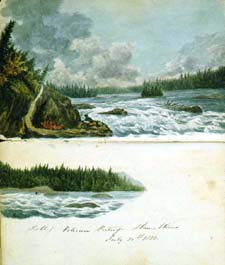 ..
..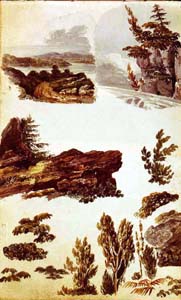
Under the entry heading "Canada", the 4th edition (1815)
Encyclopaedia Britannica offers this dreary caveat : "In Canada, the
spring, summer, and autumn are comprehended in five months, from May to
September. The rest of the year may be said to consist wholly of winter."
Presumably after that, immigration to Canada was restricted to those whose
hovel door had never been darkened by a set of encyclopaedias.
When March goes on forever And April's twice as long Who gives a damn
if spring has come As long as winter's gone.
In the 1530s, following Jacques Cartier's first voyage to the New World,
he brought back detailed accounts of the vegetative life he had seen in
the Gulf of the St. Lawrence. From 1610, when the first Jesuit missionary
arrived in Acadia, the order proved to be a gifted chronicler of the
nation-to-be.
For almost two centuries, their annual dispatches (known as the Jesuit
Relations) astonished Europeans with such New World oddities as sugar
producing
trees, riz sauvage, corn, squash and pumpkins. The Jesuits painstakingly
documented native agricultural practices, indigenous plants, and passed
along the ailmentary, medicinal, and ceremonial values ascribed to each.
Under their tutelage, aboriginals were released from the interminable
round
of camp relocation a slash-and-burn technology imposes. The Jesuits
subjected
Old World seeds to hardiness trials under New France's harsher conditions,
and propagated local varieties in special holding gardens to await
transportion
to France. So meticulous were these collections that when Jacques Philippe
Cornut published the first
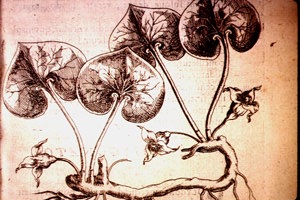 Canadensium plantarum historia, 1635
Canadensium plantarum historia, 1635
Canadian botanical in 1635, he need hardly have misplaced his pince-nez.
Thanks to their efforts, M. Cornut was able to describe the subjects of
his Canadensium plantarum historia without troubling to venture anywhere
near Canada. The disproportionate number of North American wildflowers
classified today as "Canadense" or "Canadensis" stand
as an enduring tribute to Jesuit industry.
Robins follow the 35-degree isotherm north, because at 35 degrees
Fahrenheit,
earthworms reach the surface of the thawing ground.
A map of Champlain's 1604 settlement at Isle Sainte-Croix on the Bay
of Fundy shows that
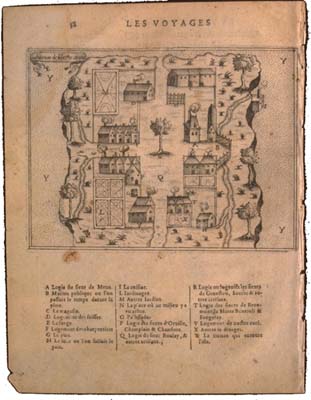
gardens were an immediate consideration. While that settlement failed,
his Quebec colony would boast a botanical garden. Canada's oldest
surviving
garden, the walled enclosure at St. Supician Seminary on Montreal's Notre
Dame Street, dates from the 1680s. By the 1670s, even the rude forts and
outposts of the Hudson's Bay Co. were planting English greens. Cape
Breton's
Fortress of Louisbourg 18th century formal potager gardens are still open
to the public.
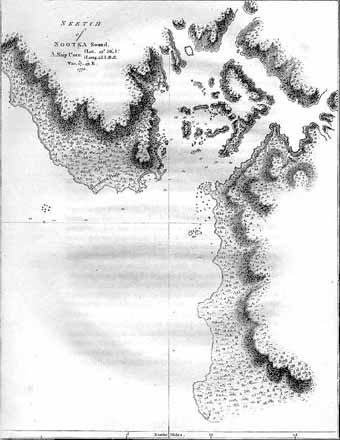 Maps of
the day depicted the bulk of the country as a great unmarked hinterland.
On British maps, this terra incognita terminated with New Albion (British
Columbia). Spain and Russia had poked about the area in a desultory kind
of way; but British ascendency was established in the spring of 1778 by
a man who had already made immense contributions elsewhere. Captain James
Cook came out of retirement to seek the fabled North-West passage. It was
to be his third, and fatal voyage. This venture brought together an
otherwise
familiar cast of historical figures. His midshipman was a 19-year-old
officer
cadet named George Vancouver; his sailing master a 21-year-old
perfectionist
named William Bligh. As the young Cook had in his day charted the
Newfoundland
coastline, so Bligh charted - accurately - the Alaskan waters where the
Exxon Valdez was to run aground 200 years later.
Maps of
the day depicted the bulk of the country as a great unmarked hinterland.
On British maps, this terra incognita terminated with New Albion (British
Columbia). Spain and Russia had poked about the area in a desultory kind
of way; but British ascendency was established in the spring of 1778 by
a man who had already made immense contributions elsewhere. Captain James
Cook came out of retirement to seek the fabled North-West passage. It was
to be his third, and fatal voyage. This venture brought together an
otherwise
familiar cast of historical figures. His midshipman was a 19-year-old
officer
cadet named George Vancouver; his sailing master a 21-year-old
perfectionist
named William Bligh. As the young Cook had in his day charted the
Newfoundland
coastline, so Bligh charted - accurately - the Alaskan waters where the
Exxon Valdez was to run aground 200 years later.
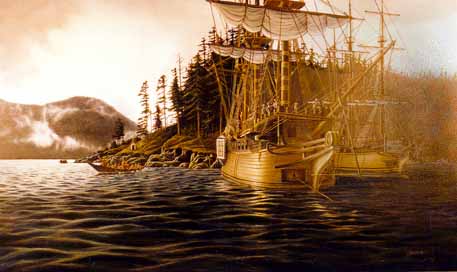 Resolution and Discovery at Nootka Sound During his first
voyage to the South Seas,
Cook's scientific team had collected 30,000 specimens.
Resolution and Discovery at Nootka Sound During his first
voyage to the South Seas,
Cook's scientific team had collected 30,000 specimens.
The effect of introducing 1,400 entirely new plant species to a world
where only 6,000 had previously been known was to accelerate knowledge
of the natural world by 25 per cent in just three years. That deluge of
information almost certainly contributed to the formulation of Thomas
Malthus'
1798 theories, which in turn inspired Charles Darwin. The chief botanist
on Cook's first voyage -- Joseph Banks -- typified the spirit of his
times.
While he was certainly driven by scientific curiousity, Banks proved an
equally tireless promoter of commercial applications for these newly
described
botanicals. Men like Banks and Cook represented the best European spirit
 Joseph Banks
Joseph Banks
during the great exploration: curious, courageous, enterprising and
inventive. As a member of the Royal Society, Banks had the requisite clout
to not only introduce tea as a cash crop to India, but to commission HMS
Bounty to transport breadfruit for cultivation from Tahiti to the West
Indies. In a further twist of fate, it was Banks again who had recognized
Australia's potential as a great open-air prison. He presented a paper
to Parliament outlining his ideas in some detail. Following the mutiny
on the breadfuit-laden Bounty, the same William Bligh was appointed
governor
to the fledgling New South Wales penal colony. He held the post for three
years -- and then his prisoners mutinied.
No wonder a mother bear with cubs is dangerous. She gives birth during
deepest hibernation and wakes to find that she has been feeding voracious
offspring ever since.
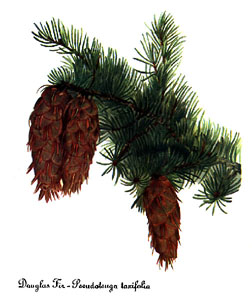 Under gruelling
conditions, New World plants were constantly being catalogued, collected,
and laboriously transported back to England. In February of 1825,
following
an eight month voyage out, David Douglas found himself deposited at the
mouth of the Columbia River. The Royal Horticultural Society had been well
advised to place their trust in the indomitable Mr. Douglas. He would
prove
very much equal to the task of examining the area supporting the most
living
matter per hectare in the world -- New Albion's coastal rain forest. When
he started back on March 20, 1827, he chose an overland route that took
him by foot over the Rocky Mountains, and from there via canoe, to York
Factory on the shores of the Hudson Bay. Incredibly, when he left for
England
on October 11, both he and his plant specimens were still alive. Known
to us for his "Douglas" fir, it was his introduction of the flowering
currant that more than subsidized the entire expedition. Douglas was to
meet an untimely end on the same Hawaiian island that had claimed the life
of Captain Cook.
Under gruelling
conditions, New World plants were constantly being catalogued, collected,
and laboriously transported back to England. In February of 1825,
following
an eight month voyage out, David Douglas found himself deposited at the
mouth of the Columbia River. The Royal Horticultural Society had been well
advised to place their trust in the indomitable Mr. Douglas. He would
prove
very much equal to the task of examining the area supporting the most
living
matter per hectare in the world -- New Albion's coastal rain forest. When
he started back on March 20, 1827, he chose an overland route that took
him by foot over the Rocky Mountains, and from there via canoe, to York
Factory on the shores of the Hudson Bay. Incredibly, when he left for
England
on October 11, both he and his plant specimens were still alive. Known
to us for his "Douglas" fir, it was his introduction of the flowering
currant that more than subsidized the entire expedition. Douglas was to
meet an untimely end on the same Hawaiian island that had claimed the life
of Captain Cook.
 Captain Cook
Captain Cook
"In the evenings we wandered through the woodland paths, beneathe
the glowing Canadian sunset, and gathered rare specimens of of strange
plants and flowers. Every object that met my eyes was new to me, and
produced
that peculiar excitement which has its origin in a thirst for knowledge
and a love of variety." (Susanna Moodie, 1832)
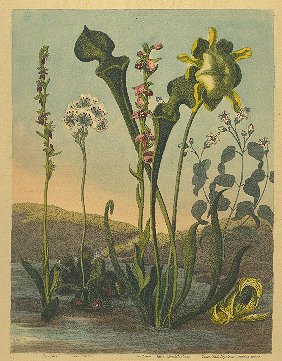 Of the 4,200
plant species growing in Canada today, only about 1,000 have been
introduced.
As the nation was settled, Canada continued to produce an improbable
number
of people eager to inventory our wealth of coastal, alpine, prairie,
woodland,
maritime and Arctic plants.
Of the 4,200
plant species growing in Canada today, only about 1,000 have been
introduced.
As the nation was settled, Canada continued to produce an improbable
number
of people eager to inventory our wealth of coastal, alpine, prairie,
woodland,
maritime and Arctic plants.
With few exceptions, when Europeans settled here, it was for life.
The seeds they brought with them nourished spiritual as much as physical
needs. Pioneer gardens quickly grew into living reminders of a world that
was lost to them forever. Among rose growing circles, there is a famous
story of a woman who had emigrated out from G ermany
with a cherished piece of rootstock from her mother's favourite rambling
rose. That annual concussion of colour and fragrance must
have served as a continual reproach, for while the cutting survived the
journey, two of her children had not. Her experience tends to put the
"anguish"
of contributing to your own language training (which some current
newcomers
allegedly feel) into the appropriate fiscal context.
ermany
with a cherished piece of rootstock from her mother's favourite rambling
rose. That annual concussion of colour and fragrance must
have served as a continual reproach, for while the cutting survived the
journey, two of her children had not. Her experience tends to put the
"anguish"
of contributing to your own language training (which some current
newcomers
allegedly feel) into the appropriate fiscal context.
"Our woods and clearings are now full of beautiful flowers. ...
You will recognize among them many of the cherished pets of our gardens
and green-houses, which are here flung carelessly from Nature's lavish
hand among our woods and wilds." (Catherine Parr-Traill, 1834)
Toward the end of the 1800s, a new sense of social responsibility was
evolving. Known as the "social gospel", people came to the (now
improbable) conclusion that benefit without contribution was unseemly
evidence
of greed. Into this fertile ground, two uniquely Canadian seeds
germinated.
Just as the British East India Company and Joseph Banks had pursued the
twin aims of pure knowledge and "impure" commerce, two of Canada's
biggest corporations would underwrite remarkable agricultural programmes.

At that time, both Canadian National and Canadian Pacific Railways
were waging aggressive recruitment campaigns to entice Europeans to settle
in rural Canada. In the case of CP, their "Railway Station Program"
-- meant to beautify unlovely prairie whistle-stops -- started modestly
enough. Then, to identify ideal local cultivars, a series of experimental
farms were established in 1884. The idea fostered goodwill and
agricultural
productivity while not inconsequentially, boosting economic growth along
CP's lines. CP freely acknowledged its motives -- good farms meant good
business. These experimental farms gradually came to encompass mixed
farming
-- even hothouse flowers -- cleverly destined for use in CP's own trains
and hotels. "Better Farming" trains began to slowly ply the prairies,
bringing lecturers and up to the minute agricultural thinking to capacity
crowds throughout isolated communities. The idea was so successful that
CN, Canadian Northern and the Grand Trunk Pacific  Railway
jumped on board. In addition to simple grain and weed information, the
teaching trains were soon shunting around blue-ribbon livestock and
poultry.
CP president Sir William Van Horne pioneered a programme of "lending
out" prize boars and bulls to improve local livestock strains -- with
the single proviso that every farm in the community must have equal access
to the stud. All aspects of rural life were represented on the
agricultural
trains: dairy, machinery, outbuildings, home economics, child care, boys
& girls magic lantern shows, tree planting, forage crops, vegetable
gardening, beneficial insects, drainage, textiles, bee-keeping, orchards,
soil conservation -- with soil analysis performed on the spot. The better
farming trains promoted innovations like irrigation, refrigeration, and
Mr. Marconi's radio. CN introduced mail-order agricultural extension
courses.
Meanwhile, those mock-Tudor CPR stations were lovingly landscaped within
an inch of their lives - intially to demonstrate how the region could
bloom
- but, finally, in a spirit of fierce competition. Thirty-eight years
after
the program's inception, the Canadian Pacific Staff Bulletin (July 1946)
acknowledged "over 1,250 employees who voluntarily maintain gardens
on Company property. To them some 10,000 packets of seeds are sent out
each season." In most areas, these enthusiastic railway initiatives
would pave the way for later university and government experimental farms,
extension departments, horticultural societies and garden clubs. It was
a remarkable contribution -- and in typical Canadian fashion -- now
utterly
forgotten.
Railway
jumped on board. In addition to simple grain and weed information, the
teaching trains were soon shunting around blue-ribbon livestock and
poultry.
CP president Sir William Van Horne pioneered a programme of "lending
out" prize boars and bulls to improve local livestock strains -- with
the single proviso that every farm in the community must have equal access
to the stud. All aspects of rural life were represented on the
agricultural
trains: dairy, machinery, outbuildings, home economics, child care, boys
& girls magic lantern shows, tree planting, forage crops, vegetable
gardening, beneficial insects, drainage, textiles, bee-keeping, orchards,
soil conservation -- with soil analysis performed on the spot. The better
farming trains promoted innovations like irrigation, refrigeration, and
Mr. Marconi's radio. CN introduced mail-order agricultural extension
courses.
Meanwhile, those mock-Tudor CPR stations were lovingly landscaped within
an inch of their lives - intially to demonstrate how the region could
bloom
- but, finally, in a spirit of fierce competition. Thirty-eight years
after
the program's inception, the Canadian Pacific Staff Bulletin (July 1946)
acknowledged "over 1,250 employees who voluntarily maintain gardens
on Company property. To them some 10,000 packets of seeds are sent out
each season." In most areas, these enthusiastic railway initiatives
would pave the way for later university and government experimental farms,
extension departments, horticultural societies and garden clubs. It was
a remarkable contribution -- and in typical Canadian fashion -- now
utterly
forgotten.
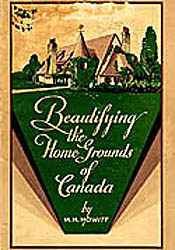
Govt of Canada publication, 1930

The Macdonald Movement in Canada, 1910
At the same time, this notion of making "better farmers"
prompted Sir William MacDonald (yes, the tobacco MacDonalds) and education
reformer James Wilson Robertson, to conceive the school gardening and
agricultural
program that came to be known as the "MacDonald Movement". "In
the two new provinces [Alberta and Saskatchewan], the number of schools
has increased from 75 in 1886 to 845 in 1904." (The Canadian West,
1904) One of the drawbacks of the teaching trains was that with very few
exceptions, information was imparted only in English. A variety of
European
immigrants had come to farm what was then a genuinely enormous country:
the challenge was not just to "channel" agricultural information
from child to parent, but to inspire the next generation to gladly stay
on magnificently productive farms. As an auxillary, the curriculum
acculturated
children, taught Canadian standards of good citizenship, and inculcated
all but forgotten virtues like self-sufficiency, individualism, and pride
in ownership.
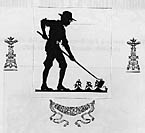 L'Agriculture à l'école primaire, 1925
L'Agriculture à l'école primaire, 1925
While the teaching trains mostly concentrated on the prairie regions,
the school program really came into its own in Ontario and the Maritimes
(though there was a great deal of crossover both ways). "In 1906,
in Carleton County, in schools without gardens 49 per cent of the
candidates
passed, while those who came from the five schools to which were attached
gardens 71 per cent were successful. Apparently the work with the hands
in the garden increased the capacity for work with books." (John W.
Chalmers, Schools of the Foothills Province: The Story of Public Education
in Alberta, 1967) In fact, nearly everyone was more enthusiastic than
school
Inspector M. E. LaZerte: ‘There are too many cases where the little mound
of earth serves to mark the grave of the seed or of the early-departed
plant.' What is of particular interest is this persistant ability to take
the long view. From Cook's voyages to these rural agricultural
innovations,
what really seemed to fire men's imaginations was the prospect of taking
a hand in an improved future -- another all but forgotten virtue.

It might be worthwhile to ask: Whatever happened to us? How could such
ambitious projects succeed in an underdeveloped and geographically
isolated
nation? Certainly there was the key individual and his vision, but in the
face of overwhelming response, these projects took on a life of their own.
Notice that no one seemed to get trampled by "dangerous" enthusiasms.
On the contrary, when Laurier pronounced the 20th century Canada's
century,
he had a per capita annual growth rate of 4.2% GDP (in real, inflation
adjusted terms) between 1896 and 1913 to back him up. By the time the
Second
World War rolled around, something had happened to Canada. Consider: when
we launched our war effort in 1939, "official" sanction for Victory
Gardens was not to be forthcoming until 1943. Throughout the war years,
the Victory Garden defined the "home" experience for millions
of Britons, Australians and New Zealanders. After the Japanese attack on
Pearl Harbour, Americans immediately put front yards, vacant lots and
public
lands under the plough.
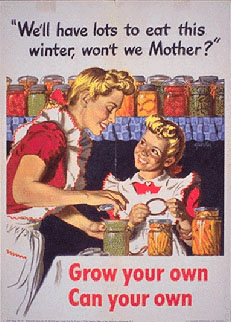 US Victory Garden Programme
US Victory Garden Programme
In a 1942 pamphlet, the Ontario Department of Agriculture fusses:
"Unless
conditions are favourable, a vegetable garden should not be undertaken.
We cannot afford to waste seed, fertilizer, equipment and energy unless
location and soil are suitable and the gardener is determined to follow
through to harvest and use." This showed a peculiar absence of confidence
in a population that was then, largely farm-raised.
A 1942 federal Dept. of Agriculture brochure maintains the finger
wagging:
"Q: Could I help the war effort by planting a vegetable garden? A:
If you have not had one before, and have not had previous experience, it
is not urged that you plant one this year." No other nation so nearly
equated a vegetable garden with top secret rocketry. When did this
official
view of Canadians as hopelessly inept bunglers gain such wide currency?
By 1943, when Ottawa had relented, year's end newspapers reported that
209,200 Victory Gardens were producing an average 550 lbs of vegetables
each.
Into the dark of January the seed catalogue bloomed - Robert Kroetsch

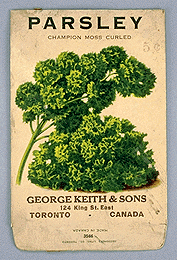
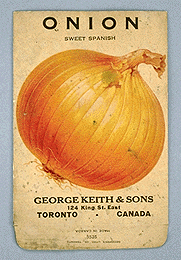
The range and diversity of plant life in late Victorian seed catalogues
was immense. To name just a few, over 150 varieties of asters, thirty or
forty nasturtiums and fifty annual phlox were on offer. A turn of the
century
census of Canadian apples lists over one hundred commonly grown varieties.
Today, we grow about half a dozen. Our forefathers grew beans that lazily
ripened on and off over the course of a growing season. People picked the
amount of beans they needed for dinner, and if they tasted good, who would
have known or cared, that they didn't "keep" or "ship"?
Again, what happened? Over the years, seedmen have bred and hybridized
beans and everything else, with large commercial growers in mind. Now,
unless you buy a "heritage variety", your plant will deliver
"desirable" keeping, shipping and ripening characteristics, often
at the expense of flavour. Worse, Monsanto has patented the so-called
"Terminator
Gene" which renders all seed (except theirs) infertile. It might be
time for Canadians to begin asking themselves whether, for the sake of
"convenience" or "niceness", we are voluntarily restricting
genuine diversity to produce a nation of simpering winter tomatoes --
outwardly
unique, but inwardly bland and lifeless. In short: without a single
redeeming
flaw.
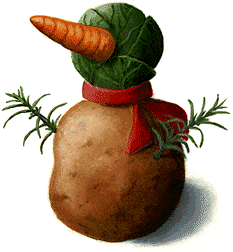 Neither fish nor fowl; building the "better" Canadian
Neither fish nor fowl; building the "better" Canadian
Seemingly, we are not even optimistic enough to obey the first
imperative
of all living beings. According to the Toronto Sun (Feb. 5, 1999), Quebec
in 1997 achieved a China-like birth rate "of 1.5 children per woman
of childbearing age. ... [In 1996, among newborns] the most common surname
on the island of Montreal was Nguyen, of Vietnamese origin. ... Runner
up to Nguyen, by the way, was Patel, of East Indian vintage." What
happened? In the mid-1700s, Quebec's birthrate was a staggering 65.2 per
1000 population and families of fifteen children were commonplace. Was
it the maypole?

"On the first of May each year, the winter snows forgotten, the
habitants arrived at the manoir in their best clothes, the youths bearing
a tall fir with branches and bark stripped to within a few feet of the
tip. This was dug in before the house, and embellished with strings and
ribbons. The seigneur and his family came out to sit in chairs and applaud
as couples kicked up their heels, dancing around the maypole. Flasks of
liquor were passed, and fusillades of blank cartridges, hand-packed for
the occasion, roared from the bushes. All were invited into the
stone-built
manoir where food was laid out on long tables. The seigneur tapped the
brandy cask and the censitaires rushed outside to blast away at the fir
pole until it was blackened with powder burns.." (Leslie Hannon, Redcoats
and Loyalists, 1978)
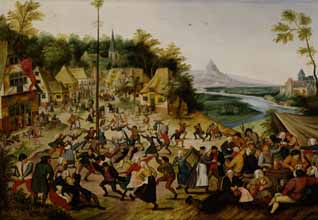
Somehow it seems appropriate that our Mayday! distress signal comes
from M'aidez! (help me) in French. While it's perplexing to think that
the Christian church appropriated so many old European holidays, it is
beyond grotesque to consider that (for most of the 20th century) the
sweetest
day of the old calendar has been the exclusive preserve of stolid,
ashen-faced
party bosses in size 54-short suits.

The first evidence of a Communist affinity for May first emerged during
that mass bloodletting of the French Revolution known as the Terror; when
ominous revolutionary maypoles (Mai Sauvage) dotted the landscape of rural
France. The message, then as now, was unmistakable: "Come, join us,
or we'll destroy you". Nothing could be further from the spirit of
mayday as it was (and often still is) celebrated in France, Spain, the
United Kingdom, the Low Countries, Germany and Scandinavia. Records of
Roman Maytime dances and processions to Floralia, the Goddess of flowers
and Spring are confidently dated to 258 BC. To the Celts, Beltaine (or
mayday) was the counterpoint to Samhain.
Oh, do not tell the Priest our plight, Or he would call it a sin; But
we have been out in the woods all night, A-conjuring Summer in! - Rudyard
Kipling, A Tree Song
From time immemorial, on the night of April 30 (now officially income
tax night) young people left their European towns and villages and went
into the fields and forests to "bring in the May". The young
women gathered flowers to bedeck themselves, their families, and their
homes, while the young men selected and cut a slender young fir sapling
full of the fertile energy of the green wood. It was, after all, a
fertility
rite, and there was always a spike of births the following January to
prove
it. Once the young men and women had collected themselves, they made a
merry procession back, stopping at each home to leave some flowers, and
receive some food and drink. On the village green, the tree was stripped
of all its branches save the crown of foliage. The maypole might be hung
with guild signs, and village exploits might be carved in the trunk in
a totemic way; but it was always decked out with herbs, flowers, ribbons
and greenery near the top.

The Queen of May and her retinue of men dressed as stags or bears,
the Lord of the May, or Jack-in-the-Green performed, and there were manly
games of strength to celebrate the God coming into his prime. Finally,
the revellers danced on the village green. Intricate plaiting designs
(barber's
pole, spider's web, Gypsy's tent) emerged from the interweaving of the
dancers and their ribbons.
There were an infinite number of Maytime variations; throughout the
length and breadth of Europe girls washed their faces in May morning dew
to stay beautiful through the year. In Switzerland the young men cut small
pine trees, called Maitannli, which they decorated and planted before the
homes of girls they admired. Only girls of good character received the
Maitannli; the looser sort might waken on mayday morning to find a
grotesque
straw puppet outside the window.
The Roman Church proved surprisingly tolerant of May festivities, going
so far as to make a tradition of crowning statues of Mary with flowers
on mayday (she too, is called the Queen of the May). The Puritans, on the
other hand, hardly knew what to despise most: the drinking - the dancing
- the debauchery? In his 1583 "Anatomie of Abuses", Phillip Stubbes
anticipated Freud by many centuries as he railed against the abomination
of the maypole: "They have twentie or fortie yoke of oxen, every oxe
having a sweet nose-gay of flowers placed on the tip of his hornes, and
these oxen drawe home this May-Pole (this stinking idol, rather), which
is covered all over with floures and hearbs, bound round about with
strings,
from the top to the bottome, and sometime painted with variable coulours,
with two or three hundred men, women and children following it with great
devotion. And this being reared up ... then fall they to daunce about it,
like as the heathen people did at the dedication of the Idols, wereof this
is a perfect pattern, or rather the thing itself. I have heard it credibly
reported (and that viva voce) by men of great gravitie and reputation,
that of forty, threescore, or a hundred maides going to the wood
over-night,
there have scarcely the third of them returned home againe undefiled."
In 1644, an obliging Parliament banned the maypole.
 The Witch Trial
The Witch Trial
If he danced, it was round the whipping-post, which might be termed
the Puritan Maypole. Nathaniel Hawthorne
When Charles II was restored to the throne a few years later, a handsome
134 foot maypole was promptly erected in London. It had long been the
practice
to advertise a daughter's betrothal with a maypole outside the home, but
maypoles sprung up spontaneously across the country as a sign of loyalty
to the crown. By 1660, mayday celebrations were again the norm. It is
significant
that for all the fanatical denunciation, Puritan persecutions never
seriously
threatened the maypole. An emerging belief system would (briefly) relegate
self-important intolerance to its proper corner, but it would, at the same
time, deprive agriculture and fertility of much of the ancient attendant
mystery. It is ironic that as the scientific method gained supremacy, it
achieved in a routine, passionless way, what repression had not.
 In 1713, a
bright new maypole was installed opposite London's Somerset House. "This
second May-pole had two gilt balls and a vane on its summit. On holidays
the pole was decorated with flags and garlands. It was removed in 1718,
and sent by Sir Isaac Newton to Wanstead Park to support the largest
telescope
in Europe." (The Dictionary of Phrase and Fable, E. Cobham Brewer,
1894) The final coup de grace came when the Victorians revived the maypole
tradition as a "rustic delight". Far from the potent fertility
symbol presiding over drunken men dressed as stags pursuing screaming
maidens,
the poor, emasculated maypole was finally reduced to a pretty prop in
children's
dancing games.
In 1713, a
bright new maypole was installed opposite London's Somerset House. "This
second May-pole had two gilt balls and a vane on its summit. On holidays
the pole was decorated with flags and garlands. It was removed in 1718,
and sent by Sir Isaac Newton to Wanstead Park to support the largest
telescope
in Europe." (The Dictionary of Phrase and Fable, E. Cobham Brewer,
1894) The final coup de grace came when the Victorians revived the maypole
tradition as a "rustic delight". Far from the potent fertility
symbol presiding over drunken men dressed as stags pursuing screaming
maidens,
the poor, emasculated maypole was finally reduced to a pretty prop in
children's
dancing games.
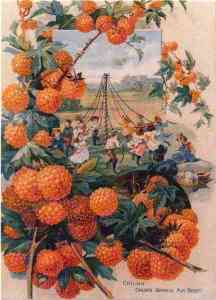
Down nearly to the ground the pole was dressed with birchen boughs,
and others of the liveliest green, and some with silvery leaves, fastened
by ribbons that fluttered in fantastic knots of twenty different colors,
but no sad ones. Garden flowers, and blossoms of the wilderness, laughed
gladly forth amid the verdure, so fresh and dewy that they must have grown
by magic on that happy pine-tree. (The May-Pole of Merry Mount, Nathaniel
Hawthorne)
"When winter comes, spring can be a lot farther behind in some
places than in others. At the southerly limit of the Great Lakes system,
on the shore of Lake Erie, the growing season - from the last frost of
spring to the first frost of autumn - usually lasts about 200 days.
Because
of the earth's tilt, sunlight strikes the fields here longer and more
directly
on a fine day in April than it does on the same day toward the more
northerly
limit of the same water system, in the St. Lawrence valley. Here the
growing
season shrinks to about 150 days. (The yellow-hearted violet called
Canadensis
blossoms almost a month later in Edmonton than it does near Niagara).
North
of the Arctic Circle spring doesn't arrive until the end of May and the
growing season doesn't last much more than 50 days. They're long days,
though, many of them with more than 20 hours of sunshine. Species that
do survive here can get through in weeks the stages of living that take
more southerly specimens months." (The Sexual Imperative, Ken Lefolii)
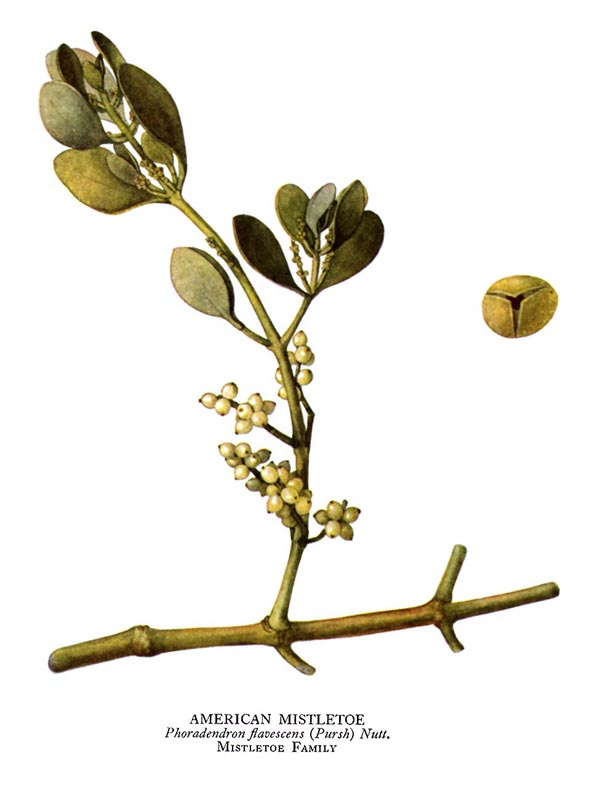
On the voyage to America 12 children were born,
of which all but one died. Of the above 262 souls embarked, 53 died on
the ocean and the remaining 221 landed safely at Halifax. There were 183
freights and 53 bedplaces. From the 8th of July 1752 to the 28th of
February
1753, 83 persons from the above-mentioned ship died in Halifax. We were
14 days travelling down the Rhine and 14 weeks on the ocean, not counting
the time we were on board the ship in Rotterdam and again in Halifax
before
we were put to ashore, all of which amounted to 22 weeks. - Excerpt from
Johann Michael Schmitt's Bible, as translated by Winthrop Bell.
A "freight" was a full-fare passenger - everyone over a certain
stipulated age, which varied from time to time or ship to ship, but was
frequently 14 years. Infants (usually under the age of 4) were carried
free and no space allocation was made for them. Children between those
ages were accounted "half-freights." Thus: Mr Schmitt meant by
the numbers of adults and of children (on the GALE from Rotterdam leaving
Leymen for America on 9 May 1752 and docking in Halifax on 8 June 1752)
were such that the 262 "souls" amounted to 183 "freights".
The still extant ship's manifest shows that there were actually 249
"souls"
and 183 "freights". The "bedplaces" were subdivisions
of the 'tween decks space in the ship, to which the emigrants were
assigned.
There were certain regulations with respect to these. The minimum
"bedplace"
size was supposed to be 6 feet square, and no more than 4 "freights"
were to be assigned to any one "bedplace." On John Dick's ships
the "bedplace" sizes were somewhat larger than the legal minimum.
Mr. Schmitt's statement means that the GALE's emigrants had somewhat more
room than they would have had the ship been filled. - Lunenberg County,
Nova Scotia genealogy discussion list


 ..
..


 Maps of
the day depicted the bulk of the country as a great unmarked hinterland.
On British maps, this terra incognita terminated with New Albion (British
Columbia). Spain and Russia had poked about the area in a desultory kind
of way; but British ascendency was established in the spring of 1778 by
a man who had already made immense contributions elsewhere. Captain James
Cook came out of retirement to seek the fabled North-West passage. It was
to be his third, and fatal voyage. This venture brought together an
otherwise
familiar cast of historical figures. His midshipman was a 19-year-old
officer
cadet named George Vancouver; his sailing master a 21-year-old
perfectionist
named William Bligh. As the young Cook had in his day charted the
Newfoundland
coastline, so Bligh charted - accurately - the Alaskan waters where the
Exxon Valdez was to run aground 200 years later.
Maps of
the day depicted the bulk of the country as a great unmarked hinterland.
On British maps, this terra incognita terminated with New Albion (British
Columbia). Spain and Russia had poked about the area in a desultory kind
of way; but British ascendency was established in the spring of 1778 by
a man who had already made immense contributions elsewhere. Captain James
Cook came out of retirement to seek the fabled North-West passage. It was
to be his third, and fatal voyage. This venture brought together an
otherwise
familiar cast of historical figures. His midshipman was a 19-year-old
officer
cadet named George Vancouver; his sailing master a 21-year-old
perfectionist
named William Bligh. As the young Cook had in his day charted the
Newfoundland
coastline, so Bligh charted - accurately - the Alaskan waters where the
Exxon Valdez was to run aground 200 years later. 

 Under gruelling
conditions, New World plants were constantly being catalogued, collected,
and laboriously transported back to England. In February of 1825,
following
an eight month voyage out, David Douglas found himself deposited at the
mouth of the Columbia River. The Royal Horticultural Society had been well
advised to place their trust in the indomitable Mr. Douglas. He would
prove
very much equal to the task of examining the area supporting the most
living
matter per hectare in the world -- New Albion's coastal rain forest. When
he started back on March 20, 1827, he chose an overland route that took
him by foot over the Rocky Mountains, and from there via canoe, to York
Factory on the shores of the Hudson Bay. Incredibly, when he left for
England
on October 11, both he and his plant specimens were still alive. Known
to us for his "Douglas" fir, it was his introduction of the flowering
currant that more than subsidized the entire expedition. Douglas was to
meet an untimely end on the same Hawaiian island that had claimed the life
of Captain Cook.
Under gruelling
conditions, New World plants were constantly being catalogued, collected,
and laboriously transported back to England. In February of 1825,
following
an eight month voyage out, David Douglas found himself deposited at the
mouth of the Columbia River. The Royal Horticultural Society had been well
advised to place their trust in the indomitable Mr. Douglas. He would
prove
very much equal to the task of examining the area supporting the most
living
matter per hectare in the world -- New Albion's coastal rain forest. When
he started back on March 20, 1827, he chose an overland route that took
him by foot over the Rocky Mountains, and from there via canoe, to York
Factory on the shores of the Hudson Bay. Incredibly, when he left for
England
on October 11, both he and his plant specimens were still alive. Known
to us for his "Douglas" fir, it was his introduction of the flowering
currant that more than subsidized the entire expedition. Douglas was to
meet an untimely end on the same Hawaiian island that had claimed the life
of Captain Cook. 
 Of the 4,200
plant species growing in Canada today, only about 1,000 have been
introduced.
As the nation was settled, Canada continued to produce an improbable
number
of people eager to inventory our wealth of coastal, alpine, prairie,
woodland,
maritime and Arctic plants.
Of the 4,200
plant species growing in Canada today, only about 1,000 have been
introduced.
As the nation was settled, Canada continued to produce an improbable
number
of people eager to inventory our wealth of coastal, alpine, prairie,
woodland,
maritime and Arctic plants.  ermany
with a cherished piece of rootstock from her mother's favourite rambling
rose. That annual concussion of colour and fragrance must
have served as a continual reproach, for while the cutting survived the
journey, two of her children had not. Her experience tends to put the
"anguish"
of contributing to your own language training (which some current
newcomers
allegedly feel) into the appropriate fiscal context.
ermany
with a cherished piece of rootstock from her mother's favourite rambling
rose. That annual concussion of colour and fragrance must
have served as a continual reproach, for while the cutting survived the
journey, two of her children had not. Her experience tends to put the
"anguish"
of contributing to your own language training (which some current
newcomers
allegedly feel) into the appropriate fiscal context. 
 Railway
jumped on board. In addition to simple grain and weed information, the
teaching trains were soon shunting around blue-ribbon livestock and
poultry.
CP president Sir William Van Horne pioneered a programme of "lending
out" prize boars and bulls to improve local livestock strains -- with
the single proviso that every farm in the community must have equal access
to the stud. All aspects of rural life were represented on the
agricultural
trains: dairy, machinery, outbuildings, home economics, child care, boys
& girls magic lantern shows, tree planting, forage crops, vegetable
gardening, beneficial insects, drainage, textiles, bee-keeping, orchards,
soil conservation -- with soil analysis performed on the spot. The better
farming trains promoted innovations like irrigation, refrigeration, and
Mr. Marconi's radio. CN introduced mail-order agricultural extension
courses.
Meanwhile, those mock-Tudor CPR stations were lovingly landscaped within
an inch of their lives - intially to demonstrate how the region could
bloom
- but, finally, in a spirit of fierce competition. Thirty-eight years
after
the program's inception, the Canadian Pacific Staff Bulletin (July 1946)
acknowledged "over 1,250 employees who voluntarily maintain gardens
on Company property. To them some 10,000 packets of seeds are sent out
each season." In most areas, these enthusiastic railway initiatives
would pave the way for later university and government experimental farms,
extension departments, horticultural societies and garden clubs. It was
a remarkable contribution -- and in typical Canadian fashion -- now
utterly
forgotten.
Railway
jumped on board. In addition to simple grain and weed information, the
teaching trains were soon shunting around blue-ribbon livestock and
poultry.
CP president Sir William Van Horne pioneered a programme of "lending
out" prize boars and bulls to improve local livestock strains -- with
the single proviso that every farm in the community must have equal access
to the stud. All aspects of rural life were represented on the
agricultural
trains: dairy, machinery, outbuildings, home economics, child care, boys
& girls magic lantern shows, tree planting, forage crops, vegetable
gardening, beneficial insects, drainage, textiles, bee-keeping, orchards,
soil conservation -- with soil analysis performed on the spot. The better
farming trains promoted innovations like irrigation, refrigeration, and
Mr. Marconi's radio. CN introduced mail-order agricultural extension
courses.
Meanwhile, those mock-Tudor CPR stations were lovingly landscaped within
an inch of their lives - intially to demonstrate how the region could
bloom
- but, finally, in a spirit of fierce competition. Thirty-eight years
after
the program's inception, the Canadian Pacific Staff Bulletin (July 1946)
acknowledged "over 1,250 employees who voluntarily maintain gardens
on Company property. To them some 10,000 packets of seeds are sent out
each season." In most areas, these enthusiastic railway initiatives
would pave the way for later university and government experimental farms,
extension departments, horticultural societies and garden clubs. It was
a remarkable contribution -- and in typical Canadian fashion -- now
utterly
forgotten.













 In 1713, a
bright new maypole was installed opposite London's Somerset House. "This
second May-pole had two gilt balls and a vane on its summit. On holidays
the pole was decorated with flags and garlands. It was removed in 1718,
and sent by Sir Isaac Newton to Wanstead Park to support the largest
telescope
in Europe." (The Dictionary of Phrase and Fable, E. Cobham Brewer,
1894) The final coup de grace came when the Victorians revived the maypole
tradition as a "rustic delight". Far from the potent fertility
symbol presiding over drunken men dressed as stags pursuing screaming
maidens,
the poor, emasculated maypole was finally reduced to a pretty prop in
children's
dancing games.
In 1713, a
bright new maypole was installed opposite London's Somerset House. "This
second May-pole had two gilt balls and a vane on its summit. On holidays
the pole was decorated with flags and garlands. It was removed in 1718,
and sent by Sir Isaac Newton to Wanstead Park to support the largest
telescope
in Europe." (The Dictionary of Phrase and Fable, E. Cobham Brewer,
1894) The final coup de grace came when the Victorians revived the maypole
tradition as a "rustic delight". Far from the potent fertility
symbol presiding over drunken men dressed as stags pursuing screaming
maidens,
the poor, emasculated maypole was finally reduced to a pretty prop in
children's
dancing games. 
